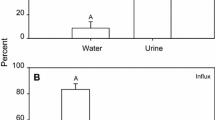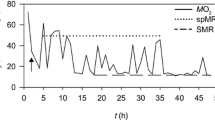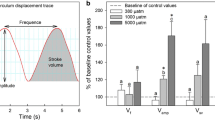Abstract
Aquatic hypercarbia (elevated environmental CO2) results in a blood acidosis in fish, which is compensated by the exchange of Na+ and/or Cl− for its acid/base counterpart (H+, HCO3 −) across the gill epithelium. To date, no studies exist on how a single species, capable of inhabiting both fresh and saltwater, responds to hypercarbia, at rest or during sustained exercise. Rainbow trout was acclimated to soft water (in mmol l− 1: Na+, 0.08; Cl−, 0.05; pH 6.7–6.8), hard water (in mmol l− 1: Na+, 2.4; Cl−, 0.2; pH 7.9–8.0), or 85% saltwater (28 ppt) (in mmol l− 1: Na+, 410; Cl−, 476; pH 7.8–8.0). Acid–base relevant blood parameters were measured during a 1 kPa CO2 hypercarbia exposure, both at rest and during sustained exercise (~ 60% U crit). After 48 h of hypercarbia, resting hard-, and saltwater trout fully restored blood pH, whereas soft-water-acclimated trout was only 60.6 ± 10.5% recovered. In all fish, recovery was associated with an increase in plasma [HCO3 −] and an equimolar reduction in plasma [Cl−]. Following 8 h of hypercarbia during sustained exercise, saltwater fish fully restored blood pH, while soft- and hard water fish were 42 ± 18.1 and 64 ± 6.8% recovered, respectively. Results provide intra-specific support demonstrating that saltwater acclimated fish acid–base compensate faster than freshwater fish during hypercarbia. Furthermore, data indicate that recovery during hypercarbia in trout is more rapid during exercise than rest. This not only demonstrates an important link between ambient water ion levels and ability to recover from acid–base disturbances, but also it presents novel data, suggesting that exercise may enhance acid–base regulation.




Similar content being viewed by others
References
Beamish FWH (1978) Swimming capacity. In: Hoar WS, Randall DJ (eds) Fish physiology, vol 7. Academic Press, New York, pp 101–187
Booth JH (1978) The distribution of blood flow in the gills of fish: application of a new technique to rainbow trout (Salmo gairdneri). J Exp Biol 73:119–129
Boutilier RG, Heming TA, Iwama GK (1984) Appendix: physicochemical parameters for use in fish respiratory physiology. In: Hoar WS, Randall DJ (eds) Fish physiology, vol 7. Academic Press, New York, pp 403–430
Brauner CJ, Baker D (2009) Patterns of acid–base regulation during exposure to hypercarbia in fish. In: Glass WL, Wood SC (eds) Cardio-respiratory control in vertebrates: comparative and evolutionary aspects. Springer, Berlin, pp 43–63
Brauner CJ, Thorarensen H, Gallaugher P, Farrell AP, Randall DJ (2000) CO2 transport and excretion in rainbow trout (Oncorhynchus mykiss) during graded sustained exercise. Respir Physiol 119:69–82
Brett JR (1964) The respiratory metabolism and swimming performance of young sockeye salmon. J Fish Res BD Canada 21(5):1183–1226
Burgetz IJ, Rojas-Vargas A, Hinch SG, Randall DJ (1998) Initial recruitment of anaerobic metabolism during sub-maximal swimming in rainbow trout (Oncorhynchus mykiss). J Exp Biol 201:2711–2721
Cameron JN, Randall DJ (1972) The effect of increased ambient CO2 on arterial CO2 tension, CO2 content and pH in rainbow trout. J Exp Biol 57:673–680
Claiborne JB, Blackston CR, Choe KP, Dawson DC, Harris SP, Mackenzie LA, Morrison-Shetlar AI (1999) A mechanism for branchial acid excretion in marine fish: identification of multiple Na+/H+ antiporter (NHE) isoforms in gills of two seawater teleosts. J Exp Biol 202:315–324
Claiborne JB, Edwards SL, Morrison-Shetlar AI (2002) Acid–base regulation in fishes: cellular and molecular mechanisms. J Exp Zool 293:302–319
Evans DH, Piermarini PM, Choe KP (2005) The multifunctional gill: dominant site of gas exchange, osmoregulation, acid–base regulation and excretion of nitrogenous waste. Physiol Rev 85:97–177
Farrell AP (2008) Comparisons of swimming performance in rainbow trout using constant acceleration and critical swimming speed tests. J Exp Biol 72:693–710
Farrell AP, Daxboeck C, Randall DJ (1979) The effect of input pressure and flow on the pattern and resistance to flow in the isolated perfused gill of a teleost fish. J Comp Physiol 133:233–240
Heisler N (1984) Acid–base regulation in fishes. In: Hoar WS, Randall DJ (eds) Fish physiology, vol 10. Academic Press, San Diego, pp 315–401
Heisler N (1986) Buffering and transmembrane ion transfer processes. In: Heisler N (ed) Acid–base regulation in animals. Elsevier Science Publishers, Amsterdam, pp 3–47
Heisler N (1999) Limiting factors for acid–base regulation in fish: branchial transfer capacity versus diffusive loss of acid–base relevant ions. In: Egginton S, Taylor EW, Raven JA (eds) Regulation of acid–base status in animals and plants. Cambridge University Press, Cambridge, pp 125–154
Hirata T, Kaneko T, Ono T, Nakazato T, Furukawa N, Hasegawa S, Wakabayashi S, Shigekawa M, Chang MH, Romero MF, Hirose S (2003) Mechanism of acid adaptation of a fish living in a pH 3.5 lake. Am J Physiol Regul Integr Comp Physiol 284:R1199–R1212
Hyde DA, Perry SF (1987) Acid–base and ionic regulation in the American eel (Anguilla rostrata) during and after prolonged aerial exposure: branchial and renal adjustments. J Exp Biol 133:429–447
Hyde DA, Perry SF (1989) Differential approaches to blood acid–base regulation during exposure to prolonged hypercapnia in two freshwater teleosts: the rainbow trout (Salmo gairdneri) and the American eel (Anguilla rostrata). Physiol Zool 62(6):1164–1186
Iwama GK, Heisler N (1991) Effect of environmental water salinity on acid–base regulation during environmental hypercapnia in the rainbow trout (Oncorhynchus mykiss). J Exp Biol 158:1–18
Jones DR, Randall DJ (1979) The respiratory and circulatory systems during exercise. In: Hoar WS, Randall DJ (eds) Fish physiology, vol 7. Academic Press, New York, pp 425–501
Kiceniuk JW, Jones DJ (1977) The oxygen transport system in trout (Salmo gairdneri) during sustained exercise. J Exp Biol 69:247–260
Larsen BK, Jensen FB (1997) Influence of ionic composition on acid–base regulation in rainbow trout (Oncorhynchus mykiss) exposed to environmental hypercapnia. Fish Physiol Biochem 16(2):157–170
Lin H, Pfeiffer DC, Vogl AW, Pan J, Randall DJ (1994) Immunolocalization of H+-ATPase in the gill epithelia of rainbow trout. J Exp Biol 195:169–183
Nilsson S (1986) Control of gill blood flow. In: Nilsson S, Holmgren S (eds) Fish physiology: recent advances. Croom Helm, London, pp 87–101
Perry SF (1982) The regulation of hypercapnic acidosis in two salmonids, the freshwater trout (Salmo gairdneri) and the seawater salmon (Oncorhynchus kisutch). Mar Behav Physiol 9:73–79
Perry SF, Gilmour KM (2006) Acid–base balance and CO2 excretion in fish: unanswered questions and emerging models. Respir Physiol Neurobiol 154:199–215
Perry SF, Shahsavarani A, Georgalis T, Bayaa M, Furimsky M, Thomas SLY (2003) Channels, pumps, and exchangers in the gill and kidney of freshwater fishes: their role in ionic and acid–base regulation. J Exp Zool 300A:53–62
Perry SF, Fletcher C, Bailey S, Ting J, Bradshaw J, Tzaneva V, Gilmour KM (2012) The interactive effects of exercise and gill remodeling in goldfish (Carassius auratus). J Comp Physiol B 182:935–945
Postlethwaite EK, McDonald DG (1995) Mechanisms of Na+ and Cl− regulation in freshwater-adapted rainbow trout (Oncorhynchus mykiss) during exercise and stress. J Exp Biol 198:295–304
Putnam RW, Roos A (1997) Intracellular pH. In: Hoffman J, Jamieson J (eds) Handbook of physiology: cell physiology. Oxford University Press, Oxford, pp 389–440
Randall DJ, Wright PA (1989) The interaction between carbon dioxide and ammonia excretion and water pH in fish. Can J Zool 67:2936–2942
Randall DJ, Rummer J, Wilson J, Wang W, Brauner CJ (2014) A unique mode of tissue oxygenation and the success of teleost fish. J Exp Biol 217:1205–1214
Rummer JL, Brauner CJ (2011) Plasma-accessible carbonic anhydrase at the tissue of a teleost fish may greatly enhance oxygen delivery: in vitro evidence in rainbow trout (Oncorhynchus mykiss). J Exp Biol 214:2319–2328
Sardella BA, Brauner CJ (2007) The osmo-respiratory compromise in fish: the effects of physiological state and the environment. In: Fernandes MN, Rantin FT, Glass ML, Kapoor BG (eds) Fish respiration and environment. Science Publisher, Inc., Enfield, pp 147–165
Shartau RB, Baker DW, Crossley DA II, Brauner CJ (2016) Preferential intracellular pH regulation: hypotheses and perspectives. J Exp Biol 219:2235–2244
Soivio A, Nynolm K, Westman K (1975) A technique for repeated sampling of the blood of individual resting fish. J Exp Biol 62:207–217
Stevens ED, Randall DJ (1967) Changes of gas concentrations in blood and water during moderate swimming activity in rainbow trout. J Exp Biol 46:329–337
Weakley JC, Claiborne JB, Hyndman KA, Edwards SL (2012) The effect of environmental salinity on H+ efflux in the euryhaline barramundi (Lates calcarifer). Aquaculture 338–341:190–196
Acknowledgements
The authors would like to thank Dr. Robert Shadwick for use of the swim tunnel, Patrick Tamkee, Bruce Gillespie, Vincent Grant, and Pak Chan for feedback on the experimental setup.
Author information
Authors and Affiliations
Contributions
Research questions were developed by KT and CJB. Experimental methods, data analysis, and manuscript preparation were conducted by KT under the supervision and in consultation with CJB. All experimental animals and equipment were provided by CJB.
Corresponding author
Ethics declarations
Conflict of interest
No competing interests declared.
Funding
This work was supported by a Natural Sciences and Engineering Research Council of Canada (NSERC) Discovery (RGPIN 261924-13) and Accelerator Supplement to C.J.B.
Additional information
Communicated by G. Heldmaier.
Rights and permissions
About this article
Cite this article
Tovey, K.J., Brauner, C.J. Effects of water ionic composition on acid–base regulation in rainbow trout, during hypercarbia at rest and during sustained exercise. J Comp Physiol B 188, 295–304 (2018). https://doi.org/10.1007/s00360-017-1129-y
Received:
Revised:
Accepted:
Published:
Issue Date:
DOI: https://doi.org/10.1007/s00360-017-1129-y




